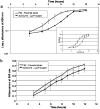Mutational and biochemical analysis of cytochrome c', a nitric oxide-binding lipoprotein important for adaptation of Neisseria gonorrhoeae to oxygen-limited growth
- PMID: 15689189
- PMCID: PMC1138962
- DOI: 10.1042/BJ20041766
Mutational and biochemical analysis of cytochrome c', a nitric oxide-binding lipoprotein important for adaptation of Neisseria gonorrhoeae to oxygen-limited growth
Abstract
Neisseria gonorrhoeae is a prolific source of c-type cytochromes. Five of the constitutively expressed cytochromes are predicted, based on in silico analysis of the N. gonorrhoeae genome, to be components of the cytochrome bc1 complex, cytochrome c oxidase cbb3 or periplasmic cytochromes involved in electron transfer reactions typical of a bacterium with a microaerobic physiology. Cytochrome c peroxidase was previously shown to be a lipoprotein expressed only during oxygen-limited growth. The final c-type cytochrome, cytochrome c', similar to cytochrome c peroxidase, includes a lipobox required for targeting to the outer membrane. Maturation of cytochrome c' was partially inhibited by globomycin, an antibiotic that specifically inhibits signal peptidase II, resulting in the accumulation of the prolipoprotein in the cytoplasmic membrane. Disruption of the gonococcal cycP gene resulted in an extended lag phase during microaerobic growth in the presence but not in the absence of nitrite, suggesting that cytochrome c' protects the bacteria from NO generated by nitrite reduction during adaptation to oxygen-limited growth. The cytochrome c' gene was overexpressed in Escherichia coli and recombinant cytochrome c' was shown to be targeted to the outer membrane. Spectroscopic evidence is presented showing that gonococcal cytochrome c' is similar to previously characterized cytochrome c' proteins and that it binds NO in vitro. The demonstration that two of the seven gonococcal c-type cytochromes fulfil specialized functions and are outer membrane lipoproteins suggests that the localization of these lipoproteins close to the bacterial surface provides effective protection against external assaults from reactive oxygen and reactive nitrogen species.
Figures







Similar articles
-
Regulation and function of cytochrome c' in Rhodobacter sphaeroides 2.4.3.J Bacteriol. 2005 Jun;187(12):4077-85. doi: 10.1128/JB.187.12.4077-4085.2005. J Bacteriol. 2005. PMID: 15937170 Free PMC article.
-
Cytochromes c': Structure, Reactivity and Relevance to Haem-Based Gas Sensing.Adv Microb Physiol. 2015;67:1-84. doi: 10.1016/bs.ampbs.2015.08.001. Epub 2015 Oct 21. Adv Microb Physiol. 2015. PMID: 26616515
-
Delivery of nitric oxide for analysis of the function of cytochrome c'.Methods Enzymol. 2008;436:21-33. doi: 10.1016/S0076-6879(08)36002-9. Methods Enzymol. 2008. PMID: 18237625
-
NO binding to the proapoptotic cytochrome c-cardiolipin complex.Vitam Horm. 2014;96:193-209. doi: 10.1016/B978-0-12-800254-4.00008-8. Vitam Horm. 2014. PMID: 25189388 Review.
-
Cytochromes P460 and c'-β: exploiting a novel fold for multiple functions.J Biol Inorg Chem. 2025 Mar;30(2):181-207. doi: 10.1007/s00775-025-02102-3. Epub 2025 Feb 26. J Biol Inorg Chem. 2025. PMID: 40009202 Free PMC article. Review.
Cited by
-
The nitric oxide (NO)-sensing repressor NsrR of Neisseria meningitidis has a compact regulon of genes involved in NO synthesis and detoxification.J Bacteriol. 2008 Apr;190(7):2488-95. doi: 10.1128/JB.01869-07. Epub 2008 Feb 1. J Bacteriol. 2008. PMID: 18245279 Free PMC article.
-
PathogenFinder--distinguishing friend from foe using bacterial whole genome sequence data.PLoS One. 2013 Oct 28;8(10):e77302. doi: 10.1371/journal.pone.0077302. eCollection 2013. PLoS One. 2013. PMID: 24204795 Free PMC article.
-
A critical role for the cccA gene product, cytochrome c2, in diverting electrons from aerobic respiration to denitrification in Neisseria gonorrhoeae.J Bacteriol. 2013 Jun;195(11):2518-29. doi: 10.1128/JB.02300-12. Epub 2013 Mar 29. J Bacteriol. 2013. PMID: 23543713 Free PMC article.
-
Peptide Inhibitors Targeting the Neisseria gonorrhoeae Pivotal Anaerobic Respiration Factor AniA.Antimicrob Agents Chemother. 2017 Jul 25;61(8):e00186-17. doi: 10.1128/AAC.00186-17. Print 2017 Aug. Antimicrob Agents Chemother. 2017. PMID: 28584144 Free PMC article.
-
Metabolic analysis of the soil microbe Dechloromonas aromatica str. RCB: indications of a surprisingly complex life-style and cryptic anaerobic pathways for aromatic degradation.BMC Genomics. 2009 Aug 3;10:351. doi: 10.1186/1471-2164-10-351. BMC Genomics. 2009. PMID: 19650930 Free PMC article.
References
-
- Vazquez-Torres A., Jones-Carson J., Mastroeni P., Ischiropoulos H., Fang F. C. Antimicrobial actions of the NADPH phagocyte oxidase and inducible nitric oxide synthase in experimental salmonellosis. I. Effects on microbial killing by activated peritoneal macrophages in vitro. J. Exp. Med. 2000;192:227–236. - PMC - PubMed
-
- Ischiropoulos H., Zhu L., Beckman J. S. Peroxynitrite formation from macrophage-derived nitric oxide. Arch. Biochem. Biophys. 1992;298:446–451. - PubMed
-
- Zhu L., Gunn C., Beckman J. S. Bactericidal activity of peroxynitrite. Arch. Biochem. Biophys. 1992;298:452–457. - PubMed
-
- Brunelli L., Crow J. P., Beckman J. S. The comparative toxicity of nitric oxide and peroxynitrite to Escherichia coli. Arch. Biochem. Biophys. 1995;316:327–334. - PubMed
-
- Veale D. R., Finch H., Smith H. Penetration of penicillin into human phagocytes containing Neisseria gonorrhoeae: intracellular survival and growth at optimum concentrations of antibiotic. J. Gen. Microbiol. 1976;95:353–363. - PubMed
Publication types
MeSH terms
Substances
Grants and funding
LinkOut - more resources
Full Text Sources

